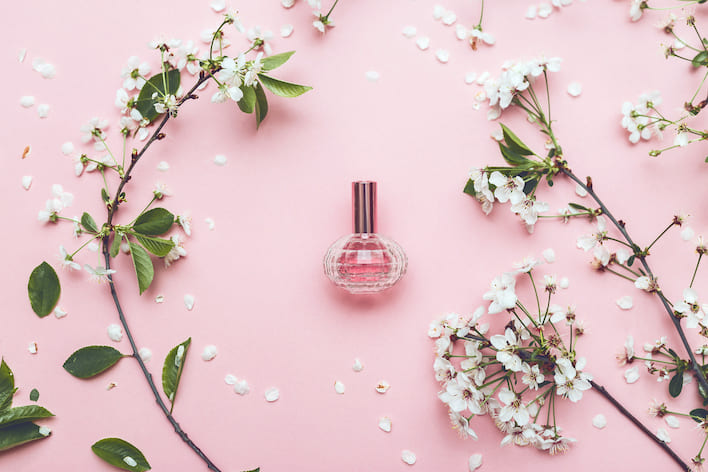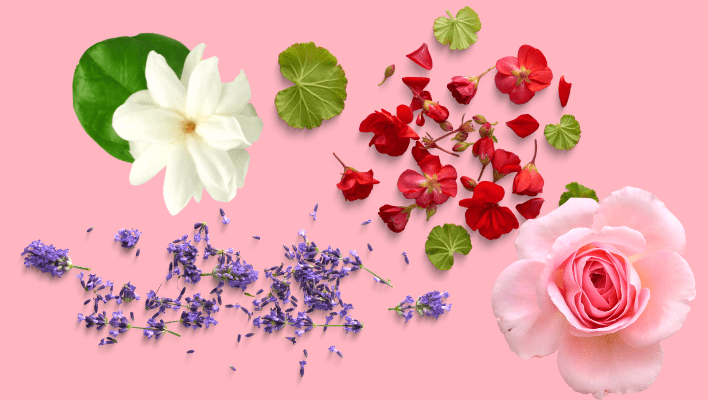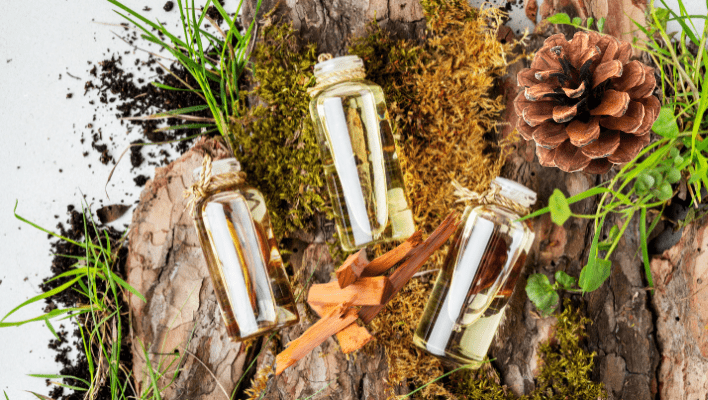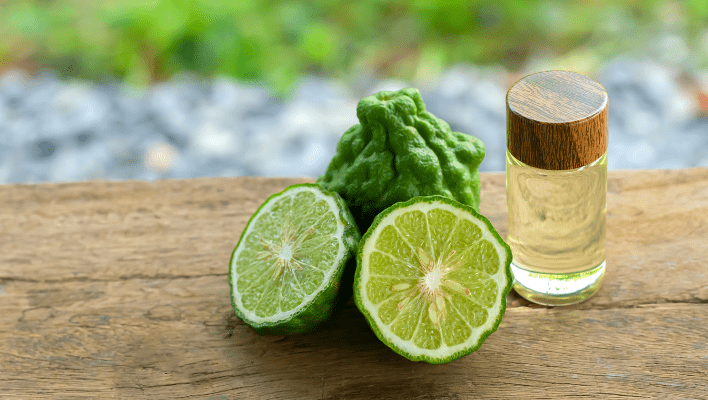It’s an age-old debate about natural and synthetic components that still floats among aficionados. And it’s fair to say that most consider the raw, unfiltered embrace of nature above the precision and innovation of modern science, but did you ever think maybe these “all-natural” perfumes aren’t that natural at all? The word ‘natural’ has become increasingly sought after by perfume brands since buyers pay more attention to what they’re putting on their skin today.

It’s good to be aware and eco-friendly, but there’s a common misconception that synthetic fragrances are bad for the environment or your skin. Contrary to popular belief, synthetic components have introduced consistency to the ever-fluctuating world of natural fragrances and added longevity to perfumes. Today’s best perfumes contain a blend of natural and synthetic materials, where the latter can acquire as much as 70% of the recipe. One example I can think of is Houbigant’s Fougère Royale with synthetic coumarin, which and another one that I love is the signature aldehyde notes from Chanel No 5.
So, for those wondering which is better or worse or why to choose one over the other, the answer lies in understanding how natural and synthetic ingredients are used in perfumes.
What are Natural Perfume Components?
Nature has always been the original perfumer in all its boundless splendor, giving us aromatic stories through its flowers, resins, woods, and even creatures. However, when you read ‘natural’ on a fragrance, it’s usually a blend of complex compounds derived from natural aromatics. These aromatics are usually from flowers, plants, trees, or animals, and since they are derived from natural sources, recreating them can be next to impossible, even if you find the same sources for the notes. And as fascinating as they are, you also can’t ignore that natural fragrances take a toll on nature.
Usually, a 100% natural fragrance contains a smaller range of notes (500 at most) extracted from various sources through different methods, such as steam distillation, solvent extraction, or expression. As I mentioned before,
Natural Fragrance Sources & Ingredients
Plants & Flowers
Perhaps the most recognized sources in perfumery, they offer a rich palette of scents.

- Roses are hailed as the queen of flowers in the world of perfumery. Their delicate aroma has made them a favorite for centuries.
- Jasmine, with its intoxicating, sensual scent, is often associated with romance and mystery.
- Lavender, celebrated for its calming properties, brings a fresh, floral-herbaceous aroma.
- Geranium offers a rosy scent with minty undertones, often used as a balancing note.
Woods & Barks

Another major source of natural fragrances are woods. Almost all top fragrances carry at least one type of wood in it since they bring depth, warmth, and longevity to fragrances. Here are a few of the many wood notes we find on luxury fragrances.
- Sandalwood is prized for its creamy, woody scent, and often finds its place in oriental and woody fragrances.
- Cedarwood, with its dry and clean profile, adds a grounding note.
- Patchouli, earthy and rich, introduces an exotic touch.
Resins & Gums

These are aromatic substances oozing from certain trees and plants, often giving fragrances a deep and resinous note. Resins are great to preserve essential oils of trees and plants for long without hindering their quality.
- Frankincense, sourced from the Boswellia tree, offers a balsamic, woody aroma with a slight citrus twist.
- Myrrh, a resin from the Commiphora tree, provides a slightly sweet, smoky, and bitter scent.
Citrus Fruits
Citrus or citric acid has a tangy freshness to it and perfumes have used the cheap natural sources of citric acid for very long. They lend a fresh, uplifting start to many perfumes.

- Bergamot, a green citrus fruit, is often the opening note in many classic colognes.
- Lemon and orange introduce zestiness, adding vivacity to fragrances.
Animal-derived Elements
These are often used as base notes, adding depth and lasting power to perfumes.
- Musk, originally derived from the musk deer, has a warm, sensual aroma. Today, due to ethical and sustainability reasons, synthetic alternatives are commonly used.
- Ambergris, a rare secretion from sperm whales, brings a sweet, woody note.
- Civet, extracted from the African civet cat, imparts a deep and musky aroma. Like musk, its synthetic alternatives are now preferred due to ethical concerns.
Why Natural Perfume Components are Good?
- Authenticity: The multifaceted profiles of natural ingredients offer a depth and richness that evoke authentic sensory experiences.
- Traditional sprays: Incorporating nature’s bounty pays homage to age-old perfume crafting practices and traditions.
Why Natural Perfume Components Are Not Good?
- Sustainability Issues: The demand for certain ingredients, like sandalwood or rosewood, can lead to over-harvesting, putting these species at risk.
- Variability: Factors like climate changes, soil conditions, and harvesting methods can lead to variations in the scent profile of natural ingredients.
- Allergens: Despite their natural origin, some ingredients, like oakmoss or certain floral extracts, can trigger allergic reactions in sensitive individuals.
Peeling back the layers of natural components is akin to a serene walk through a fragrant garden. Each note, be it floral, woody, or animalic, whispers tales of nature’s majesty, reminding us of the intricate balance between beauty, ethics, and sustainability. As we savor these natural symphonies, it’s vital to approach them with both admiration and responsibility.
What are Synthetic Perfume Components?
I think synthetic components have been vilified for quite a long time due to several misconceptions taking rounds of the internet. Contrary to popular belief, synthetic doesn’t equate to “lesser” or “toxic” or “harsh chemical.” These man-made chemical compounds almost perfectly replicate natural fragrances. In many ways, synthetic compounds have allowed us to expand the boundaries of perfumery without disrupting nature.
Synthetic Fragrance Sources & Ingredients
It’s been over a century since chemistry entered the world of perfumery and revolutionized it forever. Synthetic perfume components are created in state-of-the-art labs using chemical and natural substances. These ingredients are often the result of meticulous research and innovation. While some synthetic components may not offer the same benefits as natural counterparts such as essential oils or aromatherapy oils, they have excelled in fragrances.
Man-made Molecules and Compounds
- Aldehydes, with their waxy, citrusy, sometimes floral facets, were popularized by the iconic Chanel No. 5.
- Iso E Super exudes a cedar-like, woody scent and has become a cornerstone in modern fragrances.
- Ambroxan, a synthetic alternative to ambergris, boasts a warm, ambery aroma and is frequently used to enhance sillage and longevity.
- Calone introduced the world to the aquatic genre of perfumes with its marine, melon-like scent profile.
Recreations of Natural Scents
Sometimes, it’s about capturing the essence of natural ingredients without harvesting them. These recreations of the natural ingredients save a lot of time and money for creators, allowing them to bring cheap alternatives of natural fragrances.
- Vanillin, a recreation of the delightful vanilla scent, is probably the most recognized synthetic aroma.
- Hedione, which mimics the airy freshness of jasmine, has found its way into numerous fragrances.
Entirely New Aromas
Synthetic components haven’t only been about replicating. There are new notes that don’t have a direct counterpart in nature but have enriched the olfactory palette immensely.
- Ozonic notes capture the essence of fresh air after a rainfall or the crispness of a breezy seashore.
Why Synthetic Perfume Components are Better?
- Consistency: This is the biggest differentiator between the two and enough to keep synthetic fragrances in your collection. Synthetic components remain unaffected by the vagaries of weather or environmental factors, ensuring a standardized scent profile batch after batch, something 100% Natural will fail to do.
- Sustainability: By relying on lab-created versions, we reduce the strain on natural resources, ensuring endangered plants or animals are preserved.
- Expanded Palette: As I mentioned before too, introduction of synthetics has opened the gates to an array of novel, unprecedented fragrances that would be unimaginable with only natural ingredients.
Why Synthetic Components are Not Good?
- Perception: Synthetics often battle the stigma of being perceived as ‘artificial’ or ‘less authentic’ compared to their natural counterparts. That may be the reason why most top fragrances infuse natural components too, and label their scents as ‘natural’.
- Allergic Reactions: Much like natural components, certain synthetic ingredients can trigger sensitivities or allergies in individuals.
Final Word
As we reach the end of this piece, it’s evident that the line between natural and synthetic isn’t as clear-cut as one might think. Hope I succeeded in breaking some myths around synthetic components and uncovering more detailes on both. In our pursuit for all things “natural,” it’s essential not to overlook the significant benefits and innovations that synthetic components bring to the world of perfumes.
Instead of looking for ‘natural vs. synthetic’, it would be wise for us to focus on understanding the composition, longevity, and safety of the fragrances we choose. In the end, whether you gravitate towards a purely natural scent or embrace the allure of a blended perfume, it’s the artistry, passion, and story behind each bottle that truly makes a fragrance memorable. Let your senses guide you, and remember, every perfume has its unique story, whether born from nature, science, or, most often, a blend of both.










